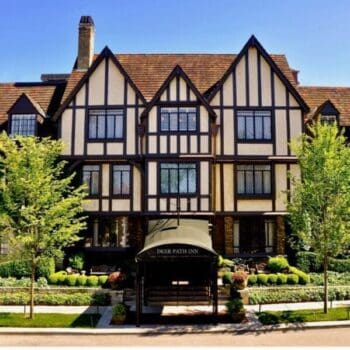 Sleep tourism may be a relatively new buzz term, but for hospitality it isn’t really anything novel; it’s an extension and more deliberate expansion of what hotels aim to achieve each and every night. After all, one of the hallmarks of guest satisfaction, and a core part of any hotelier’s duty of care, is whether or not the guest slept well. Knowing this principle, leading brands are engaged in an arms race of sorts to meet the increasing cultural appreciation and prioritization for sleep amenities. Often lost in this conversation, though, are independent hotels.
Sleep tourism may be a relatively new buzz term, but for hospitality it isn’t really anything novel; it’s an extension and more deliberate expansion of what hotels aim to achieve each and every night. After all, one of the hallmarks of guest satisfaction, and a core part of any hotelier’s duty of care, is whether or not the guest slept well. Knowing this principle, leading brands are engaged in an arms race of sorts to meet the increasing cultural appreciation and prioritization for sleep amenities. Often lost in this conversation, though, are independent hotels.
The Deer Path Inn, a 57-key, four-star property in Lake Forest, Illinois, on Chicago’s North Store, is one such example wherehould, examin the introduction of a thoughtful and appropriately themed sleep program serves to show that any hotel can, and se how they can upgrade their amenities to appease modern traveler demands. Sitting down with James Barnett, General Manager of the property since September 2023, we talked through the full extent of the new sleep program as well as its context within the broader evolution of this now 95-year-old historic inn.
Property in focus

On the approach to its centennial anniversary coming up in 2029, the Deer Path Inn recently completed a full-scale property improvement plan (PIP) in 2015, where ownership and the management group, Charlestowne Hotels, worked hand-in-hand to ensure that the building’s heritage and its significance for the North Shore’s growth over the past century were both preserved, even as they went down to the studs in order to properly update many of the rooms and facilities. As an Australian who has also spend many years in London’s hospitality scene, Barnett was well-versed with how the expressiveness of a hotel’s heritage can directly and indirectly heighten brand awareness and revenues.
Like so many historic hotels around the world, the team behind the Deer Path Inn has a great sense of responsibility in being a steward for the city around it. Embracing its British countryside theme meant carefully sourcing furnishings and finishings for the latest renovation in order to maintain that antique charm and match previously used materials, while also adding archival photography or other refurbished pieces to the guestrooms and public spaces like the signature restaurant, The English Room. With the adjacent Garden Room and conservation area along with the secluded Courtyard patio, together these F&B outlets contribute nearly half of total revenue.
This contribution highlights an interesting aspect about the property’s unique segmentation mix; for hotel guests this is at approximately 60% leisure, 25% corporate and 15% group as Barnett recalled. Besides in-house guests, the Deer Path Inn certainly draws in a sizable local crowd for dining and its event series, while most travelers are booking because they adore the upscale, storybook décor and exceptional service. For instance, even to this day a member of the team calls every guest ahead of their arrival. These touches offer a clear value-add above the local comp set and even for properties closer to Chicago’s downtown core.
Transients can include, for example, local getaways from within three hours’ drive, midweek corporate travelers looking for a sophisticated home base or those visiting the area for graduations, while the inn has strong relationships with nearby businesses looking for an intimate yet stately venue for C-level retreats. Then for wedding parties, for which the inn hosts many, the whimsical backdrops of the various venue spaces can host up to 175 attendees. Taken together, for the setup of the sleep program, staying true to its heritage and to current guest expectations has meant focusing on embellishing their culinary expertise and English-inspired theme.
 Sleep program in focus
Sleep program in focus
“The last memory a guest has of a property when checking out in the morning is how well they slept the night before,” commented Barnett. “If they don’t get good sleep, that will emotionally transfer back on to the host property. The senior team has understood this since well before the last major PIP, and from the beginning of that refurbishment set aside budget for a selection of higher-end mattresses, linens and bedding supplies known to elicit better sleep.”
This simple yet wholly relatable concept acted as the impetus for the new sleep program that Barnett oversaw. Indeed, it’s supported by psychology through what’s called the ‘peak-end rule’ where people are most likely to remember the peak of a given experience as well as its ending. It follows that if you fumble the departure – the ending of a hotel experience – then that mishap may outweigh other positives during the course of the stay.
With respect to helping guests get better sleep in order to improve the end experience, the Deer Path Inn’s specific offering here is called ‘A Good Book & A Spot of Tea’. True to its name, it includes a bedtime tea service, snacks and a curated ‘Sleepy Sips’ playlist, along with a book selected for guests by the Lake Forest Book Store. The property’s Chief Spirits Officer has also crafted a complimentary lavender mocktail and will offer a trio of cocktails inspired by English authors (The Charles Dickens, The Jane Austen, The William Shakespeare). Lastly, the inn has partnered with luxury loungewear clothing line Sleepy Jones to debut its own branded Deer Path Inn PJs, available in the gift boutique as well as on their ecommerce channel.
While it may seem relatively straightforward to focus on the bedding, herbals and inspired cocktails, this belies the multitude of work that happened behind the scenes in order to verify the program and keep it in harmony with all the other elements that together constitute the guest experience. For example, the inn consults with sleep experts, while they also involved members of the housekeeping team throughout the process to ensure operational feasibility. Above all, Barnett noted that they relied on firsthand feedback and personal interactions with guests to guide both the PIP and the sleep program’s rollout. Such is an advantage that only independents can really have: a deep relationship with key guests and the flexibility to adapt to their individual requests.
Part of a larger mission
 While the sleep program was only recently debuted, unofficially it has been in works on an evolving scale since the early planning for the PIP in 2015. It is part of a broader strategy that’s focused on maintaining a unique, time-honored sensibility that uplifts the community. Sleep is but one spoke on this wheel.
While the sleep program was only recently debuted, unofficially it has been in works on an evolving scale since the early planning for the PIP in 2015. It is part of a broader strategy that’s focused on maintaining a unique, time-honored sensibility that uplifts the community. Sleep is but one spoke on this wheel.
“As an independent, we still have to play to our strengths,” added Barnett. “At only 57 rooms, we may not have the widest range of amenities like some of the larger chain hotels or resorts, especially when it comes to outdoor space or wellness programming. But we punch far above our weight when it comes to unique charm, dining, service, events and, especially with the official launch of our new sleep program, in-room relaxation.”
The broader strategy that includes the PIP and the sleep program is culminating in the centennial, where Barnett is now focusing on overseeing a new summer event series in the central courtyard as a way of highlighting the hotel’s history and giving back to Lake Forest. This includes the ‘Summer Soirée’ that plays homage to traditional British innkeeping and ‘Dine Like It’s 1929’ with menus inspired by what the hotel would’ve served during the Roaring Twenties – and also with some help from the local preservation society to ensure they’re getting it right.
Overall, the point is that a sleep program doesn’t necessarily have to be any major pivot for any property. With the continued growth of sleep tourism, these programs can bring together the best of what a property already does in the areas of service, F&B, wellness or technology. And per the peak-end rule, sleep programs should thus be on every hotel’s radar, but they can also be a part of a greater multi-year strategy, especially when a PIP is being mapped out. Independents like the Deer Path Inn are showing that with the right strategy and thoughtful planning this can be executed in a way that enhances the onsite storytelling and overall experience.
This article may not be reproduced without the expressed permission of the authors.


 Sleep program in focus
Sleep program in focus
















